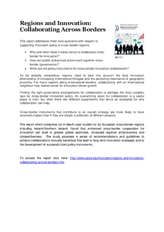Published: 2013
This Organisation for Economic Co-operation and Development (OECD) report addresses three core questions with respect to supporting innovation policy in cross-border regions:
- Why and when does it make sense to collaborate cross-border for innovation?
- How can public and private actors work together cross-border (governance)?
- What are the policy instruments for cross-border innovation collaboration?
To be globally competitive, regions need to take into account the dual innovation phenomena of increasing international linkages and the persisting importance of geographic proximity. For many regions along international borders, collaborating with an international neighbour may makes sense for innovation-driven growth.
Finding the right governance arrangements for collaboration is perhaps the most complex task for cross-border innovation policy. An overarching vision for collaboration is a useful place to start, but often there are different experiments that serve as examples for why collaboration can help.
Cross-border instruments that contribute to an overall strategy are more likely to have economic impact than if they are simply a collection of different projects.
The report which comprises six in-depth case studies for six European cross-border regions including Ireland-Northern Ireland, found that enhanced cross-border cooperation for innovation can lead to greater global openness, increased regional attractiveness and competitiveness. The study proposes a series of recommendations and guidelines to achieve collaborations mutually beneficial that lead to long-term innovation strategies and to the development of successful joint policy instruments.
Visit the OECD website to read the Regions and Innovation: Collaborating Across Borders book online

